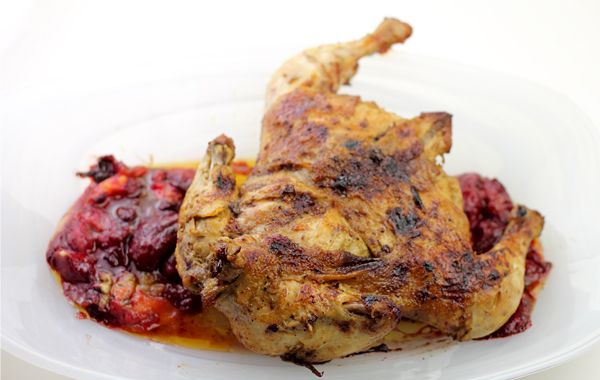This year, we’ve been fortunate that the gophers and squirrels haven’t made off with our fruits and veggies. All our trees have produced prolific crops of fruit, but the plum trees really stand out. We were able to gather large baskets of Santa Rosa plums, Red Raven plums and pluots.
I made a coffee cake with some of the plums and used the rest in this roast chicken dish. The acidity of the plums is an effective tenderizer for the meat, and the sweetness provides contrast. In the past I’ve used other fruits such as Asian pears and the plums worked wonderfully as well. I also added whole peeled plums at the end of the cooking as a garnish and as a reminder of the flavors that permeate the chicken and as the garnish.
I butterflied a whole chicken and placed it in a roasting pan on a bed of celery stalks so the chicken didn’t burn and remains moist. I basted the meat several times; this extra step really makes a difference in ensuring that the final product is moist and delicious. Yum!
1. Info for Plum Chicken (Roasted Chicken Recipe)
- Cook Time: unavailable
- Total Time: unavailable
- Servings: 4
- Calories: unavailable
2. Ingredients for Plum Chicken (Roasted Chicken Recipe)
- 1 (3-½-pound) whole chicken
- 1 tablespoon kosher salt (or regular salt)
- 1 tablespoon sweet paprika
- 1 tablespoon ground coriander
- 1 tablespoons ground fennel
- 1 tablespoon green, pink, black peppercorn medley, freshly cracked
- 4 cloves fresh garlic, finely minced
- 2 pounds plum medley, peeled (see tips) and pitted
- 1 bunch celery, separated
- 6 tablespoons butter, softened
- 3 tablespoons olive oil
- 1 cup chicken stock
3. Directions:
- In a mortar and pestle, grind the colored peppercorns. Add ground coriander, ground fennel, red chili powder, paprika and 3 tablespoons of butter. Mix until well combined.
- Coarsely chop and gather 1 cup of plums with their juice.
- Clean the chicken thoroughly. Crack every part with bones so the chicken can be easily flattened. Remove the fat chunks near the bottom of the chicken. Leave the skin on. Pat the chicken dry with a paper towel.
- Season the chicken with 2 teaspoons of kosher salt. Mix the garlic, chopped plums and baking soda; be sure they’re well incorporated. Place the whole chicken on a large tray. Wearing gloves, carefully separate the skin from the flesh without tearing it. Spread all the mixture under the skin, in the cavity and on the outside of the bird. Rub evenly. Drizzle with about 1 tablespoon of melted butter. Marinate in the refrigerator for at least 2 hours, preferably overnight. You can marinate the bird up to 2 nights.
- Preheat the oven to 375°F.
- Remove the chicken from the refrigerator at least 30 minutes ahead of time to bring it back to room temperature before placing in the oven.
- Make sure the inside of the cavity is filled with marinade.
- Brush a roasting pan with olive oil. Cover with the celery stalks (cut them in half if necessary so they fit the pan). Drizzle both side of the chicken with a tablespoon of melted butter and the rest of olive oil. Sprinkle with more salt. Place the chicken, breast side up, on top of the celery. Add chicken stock to the bottom of the pan.
- Roast for 40 min. Open the oven and baste the bird with the drippings from the pan. Increase the temperature to 400°F and roast for 10 more minutes to brown the chicken. Flip the bird, add the rest of the plums (peeled, halved, pitted fruits) and continue cooking for an additional five minutes until the other side is browned as well.
- Remove the chicken from the oven. Loosely cover with foil (don’t entirely wrap it or the skin won’t be crispy). Let it rest for at least 10 minutes.
- A thermometer should register 165°F in the thickest part of the bird or the juice should run clear when you crack around the thighs.
- Reserve drippings at the bottom of the roaster, discarding as much oil (fat) as possible and serve on the side. Garnish with the roasted plums on the side as well. Bon appétit!
4. Tips and advices:
- I use a Messermeister brand vegetable peeler; it’s very sharp and makes very thin peels.
- Did you know? Pluots are for people who live in parts of the country where they’re not common.

